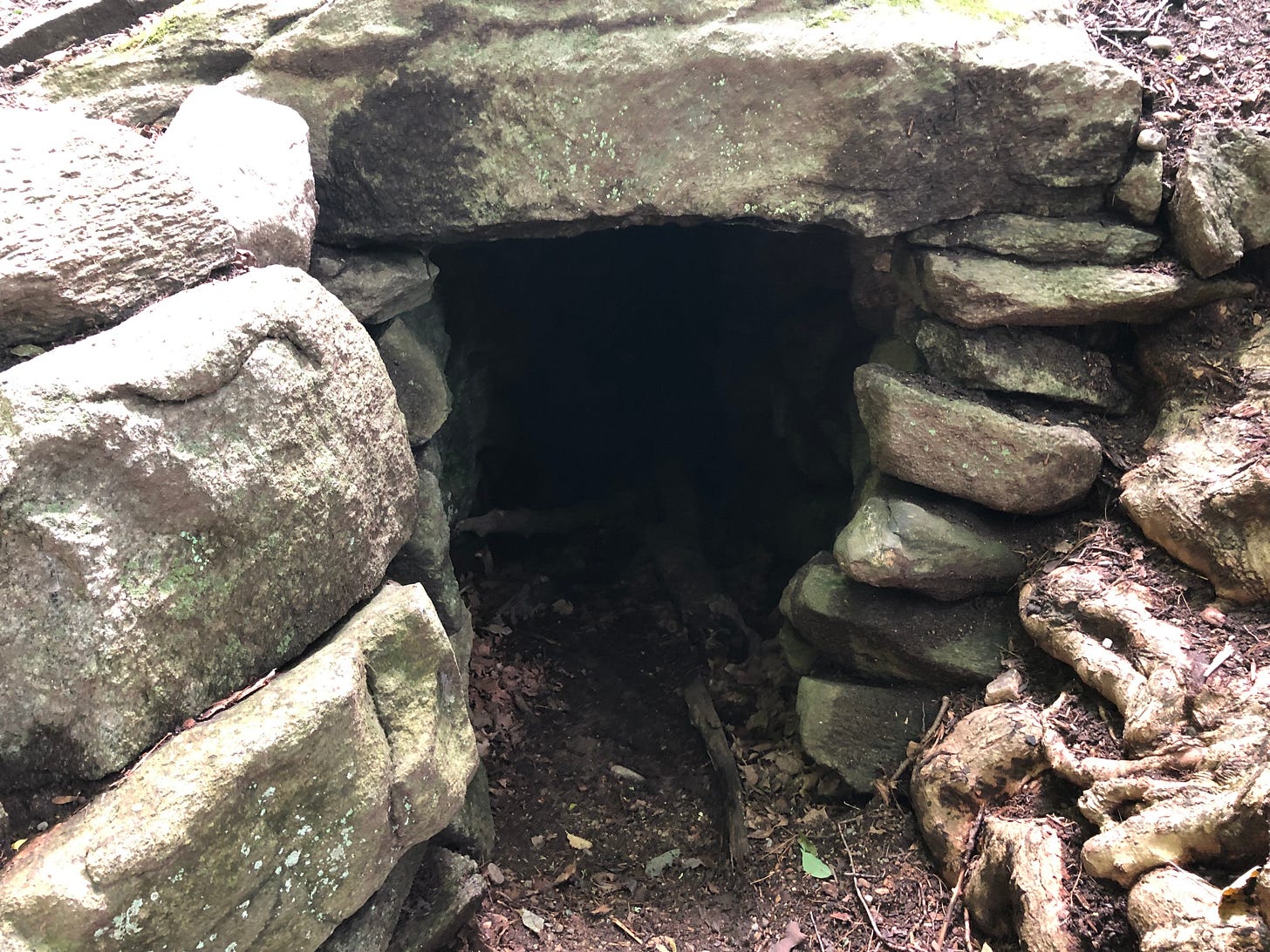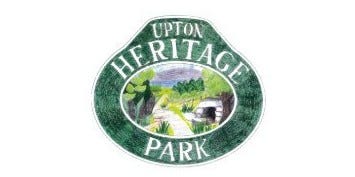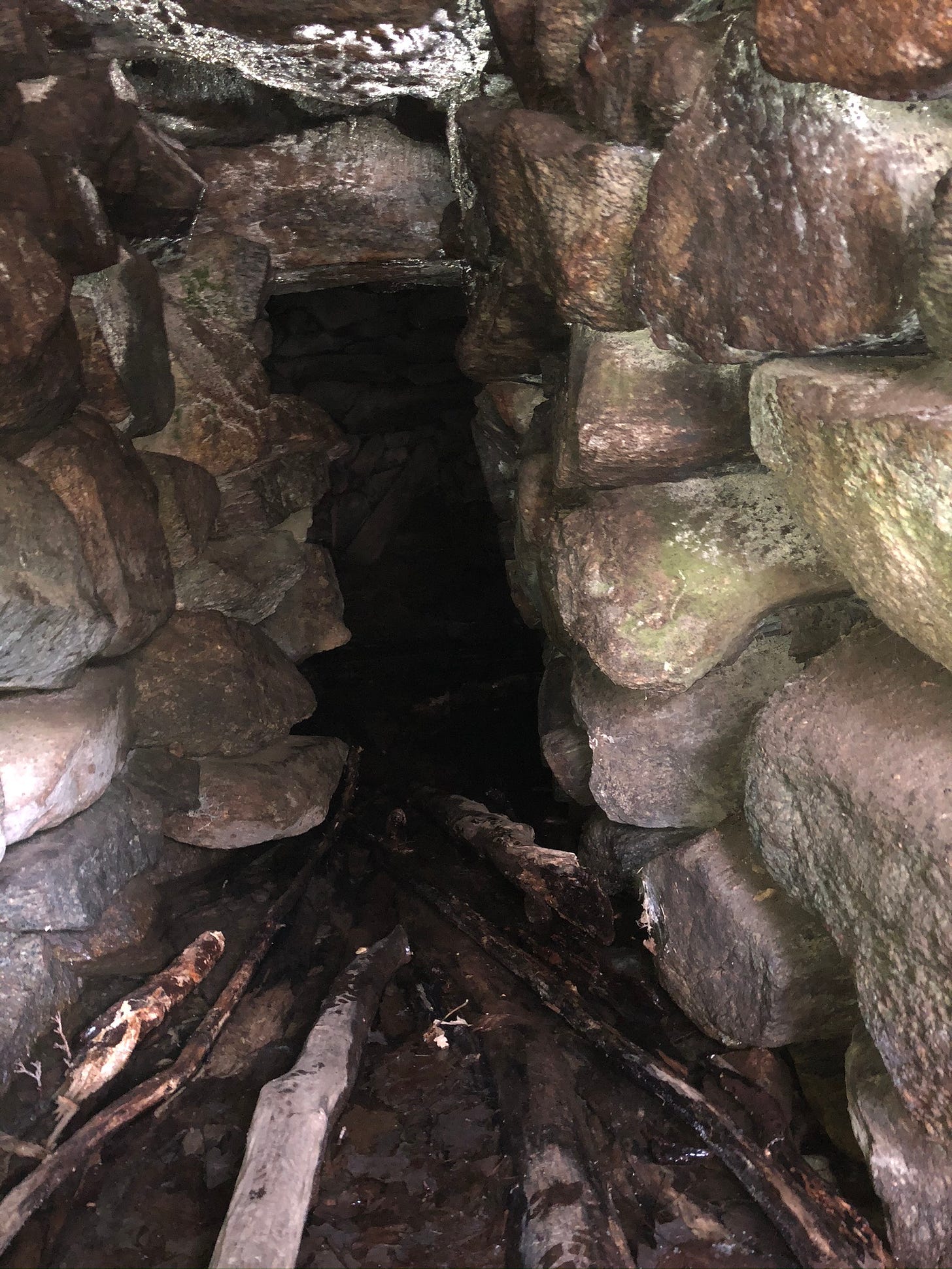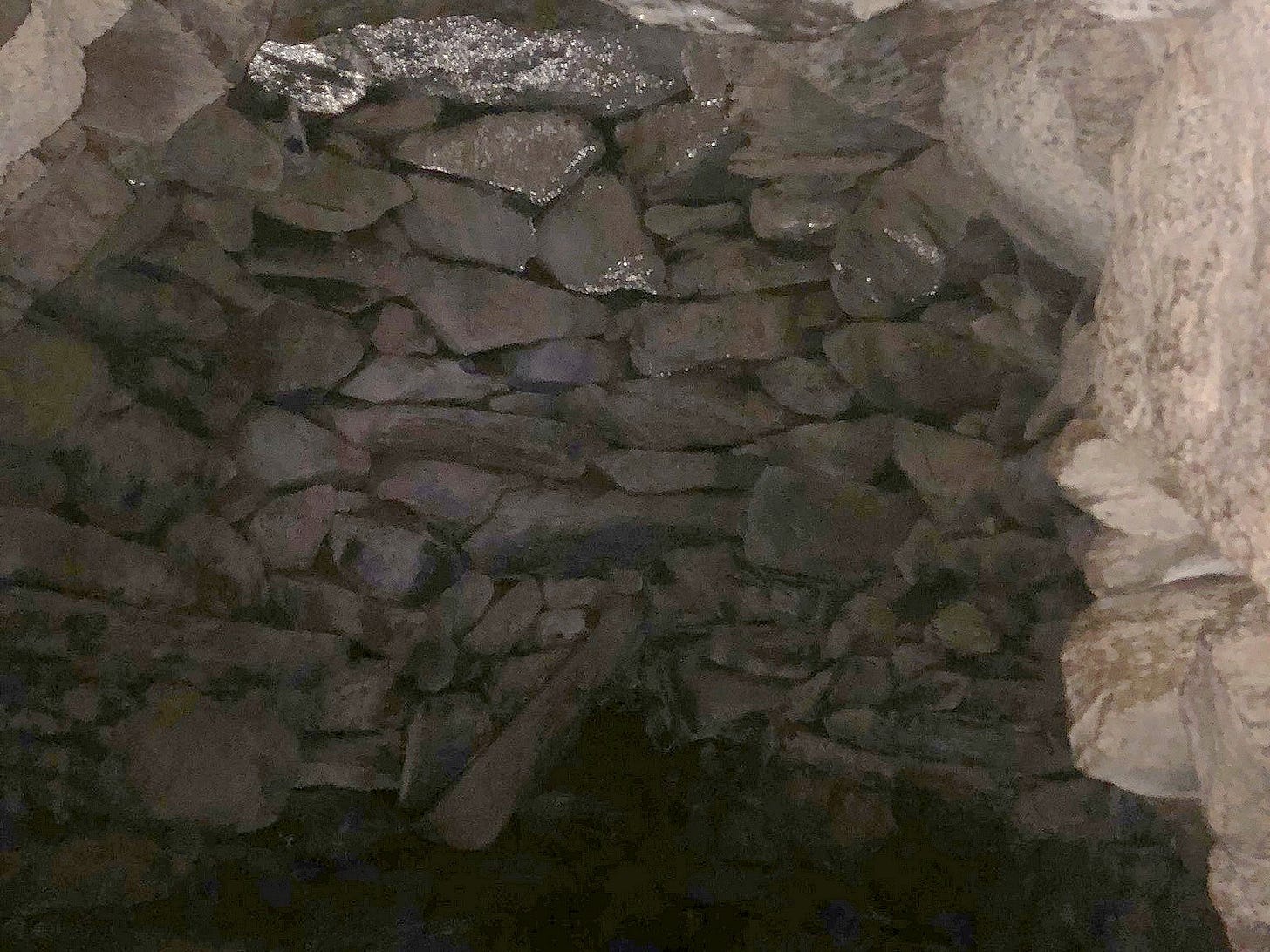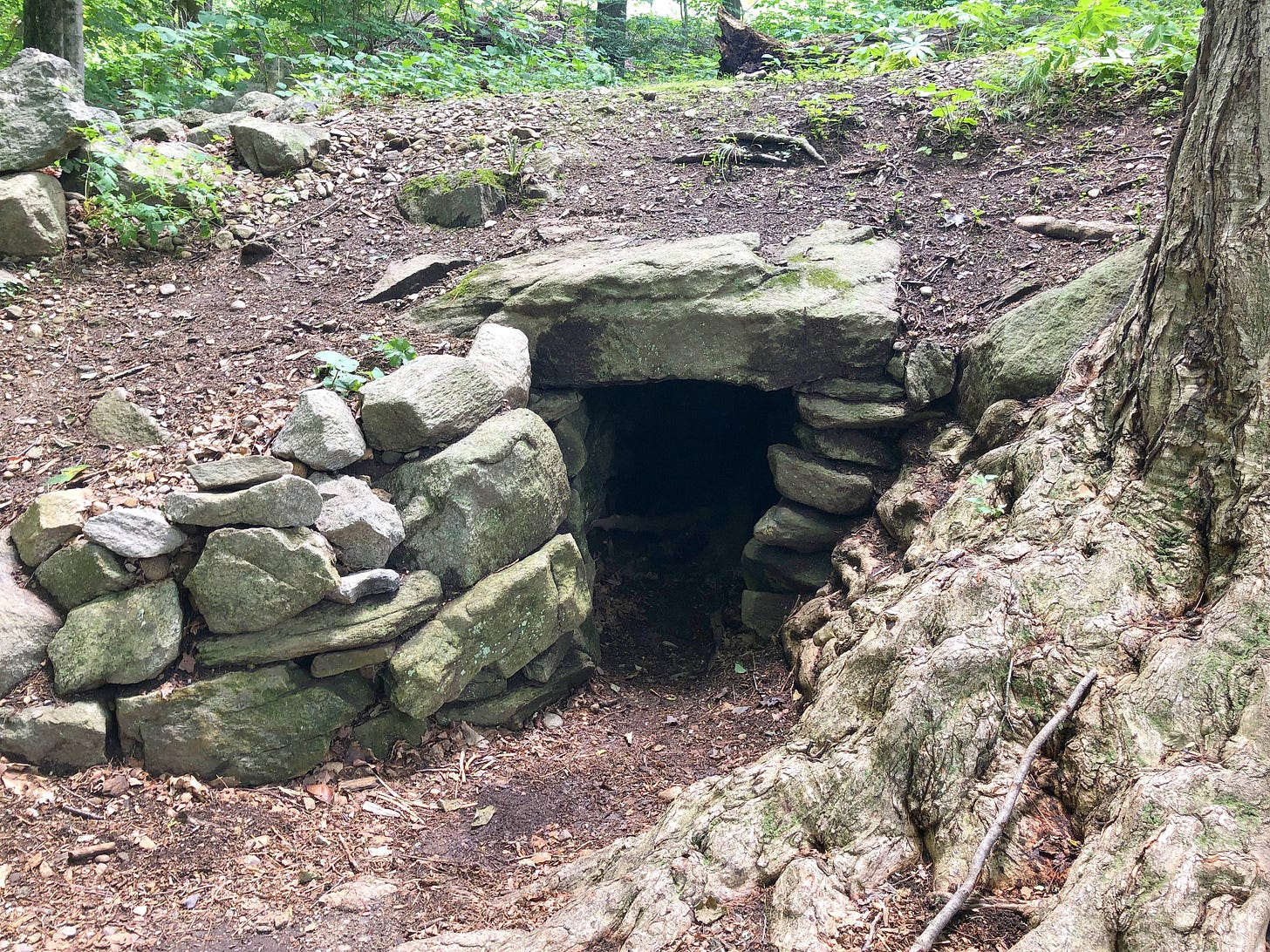Into the Stone Beehive
Following your GPS to the Upton Heritage Park leads you down a couple of winding neighborhood roads and into a driveway-like entrance as you reach your destination. Pulling in, you park on the left, next to a kiosk.
A picture on the kiosk confirms you’ve reached the right place — it displays the interior diagram of a beehive- or igloo-shaped stone chamber: The Upton Stone Chamber.
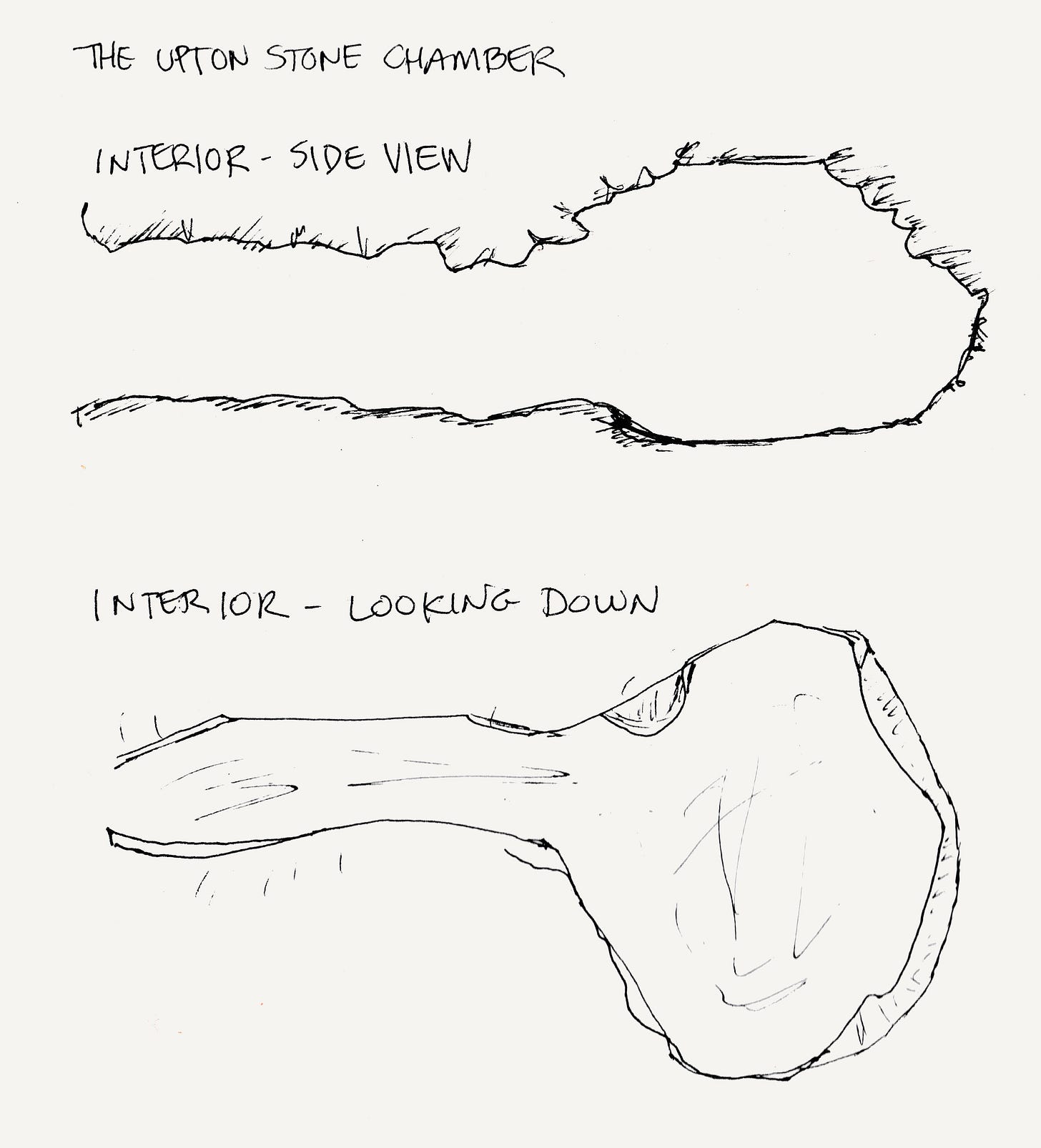
In 2015, Optical Luminescence Dating (OSL) placed construction of this dome-shaped corbelled stone chamber at around 500 to 800 years ago, from about 1250 to 1500 AD. Follow up dating and testing is in the works. But in all likelihood this stone chamber pre-dates the arrival of European settlers here by hundreds of years, if not more.
The entrance tunnel is about fifteen feet long, between two to two-and-a-half feet wide and about five feet high. It seems to usually be flooded, now.

The tunnel opens up on a fairly spacious circular interior chamber, about ten feet across — the dome of the chamber is also about nine or ten feet high at its tallest. As you can see in the photographs, the interior chamber floor is also under water.
The Inner Upton Experience
We’re not just visiting the Upton Stone Chamber. We’re traveling back through time for this tale of depth perception. This beehive-shaped stone chamber was the third stop on my very first day of field exploring a couple of years ago, at the end of 2019.
The Acton or Nashoba Brook Stone Chamber had been my previous stop. That one was pretty cool. But not... profound.
My Acton stone chamber experience was nothing like my Upton one.
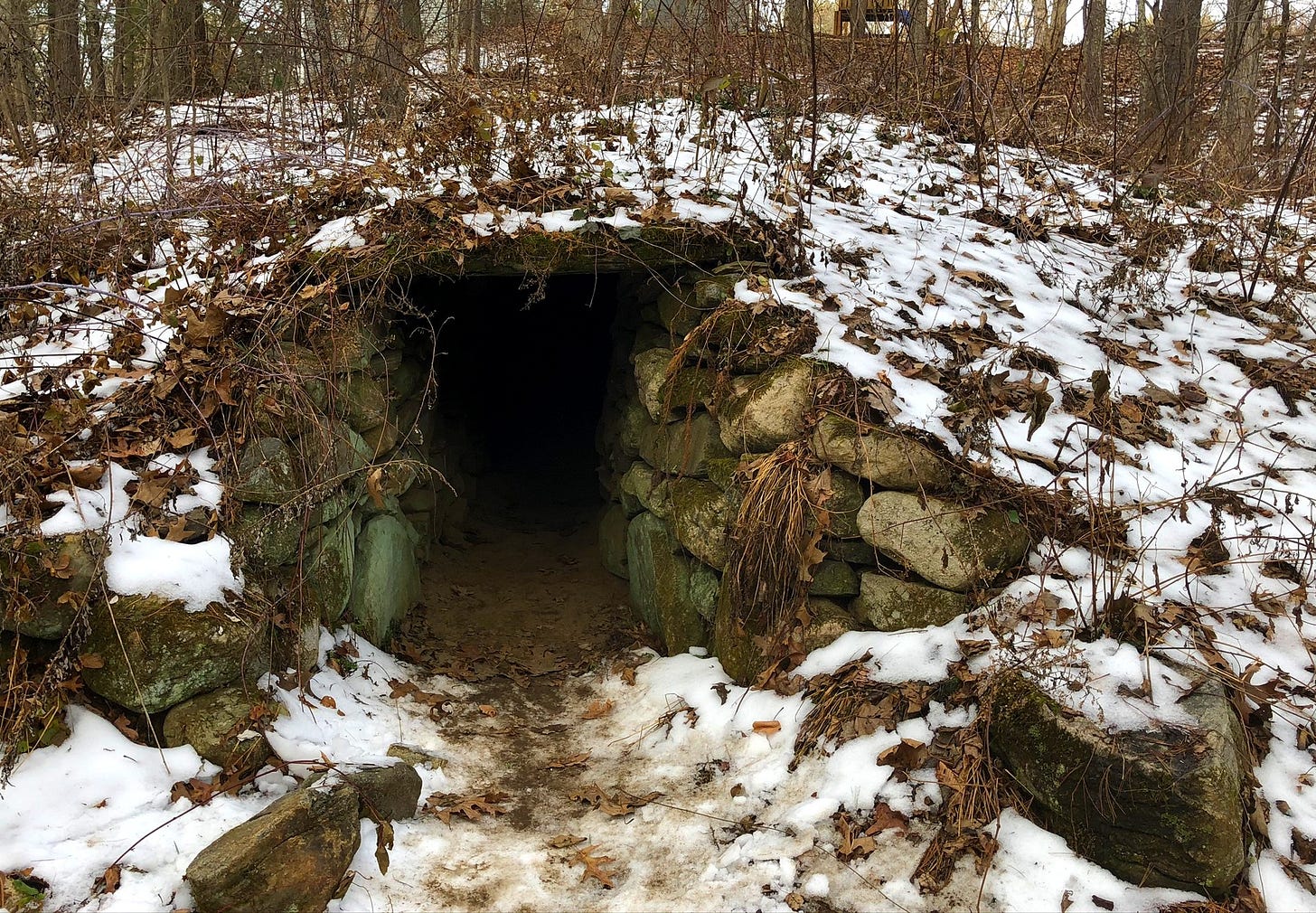
My first stop that day, the Druid Hill Stone Circle in Lowell, is hardly worth mentioning. It’s name is ten times cooler than the place is in real life. Although, it does photograph well, from the right angles.
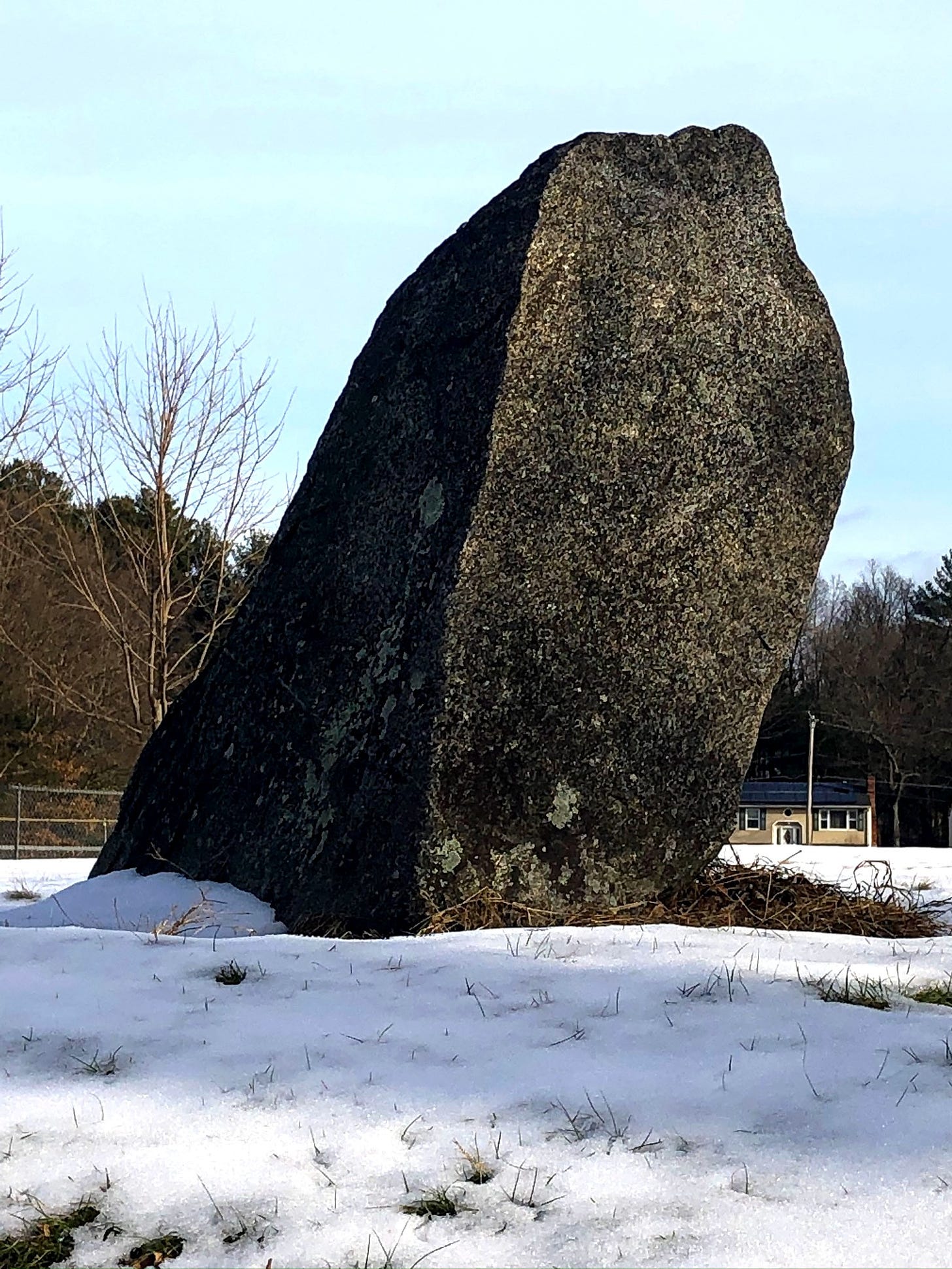
Before I went into this Upton Stone Chamber, I was still considering the possibility there may have been pre-Columbian European Explorers over here in the New World, building things like this stone chamber.
Experiencing this chamber made me feel otherwise.
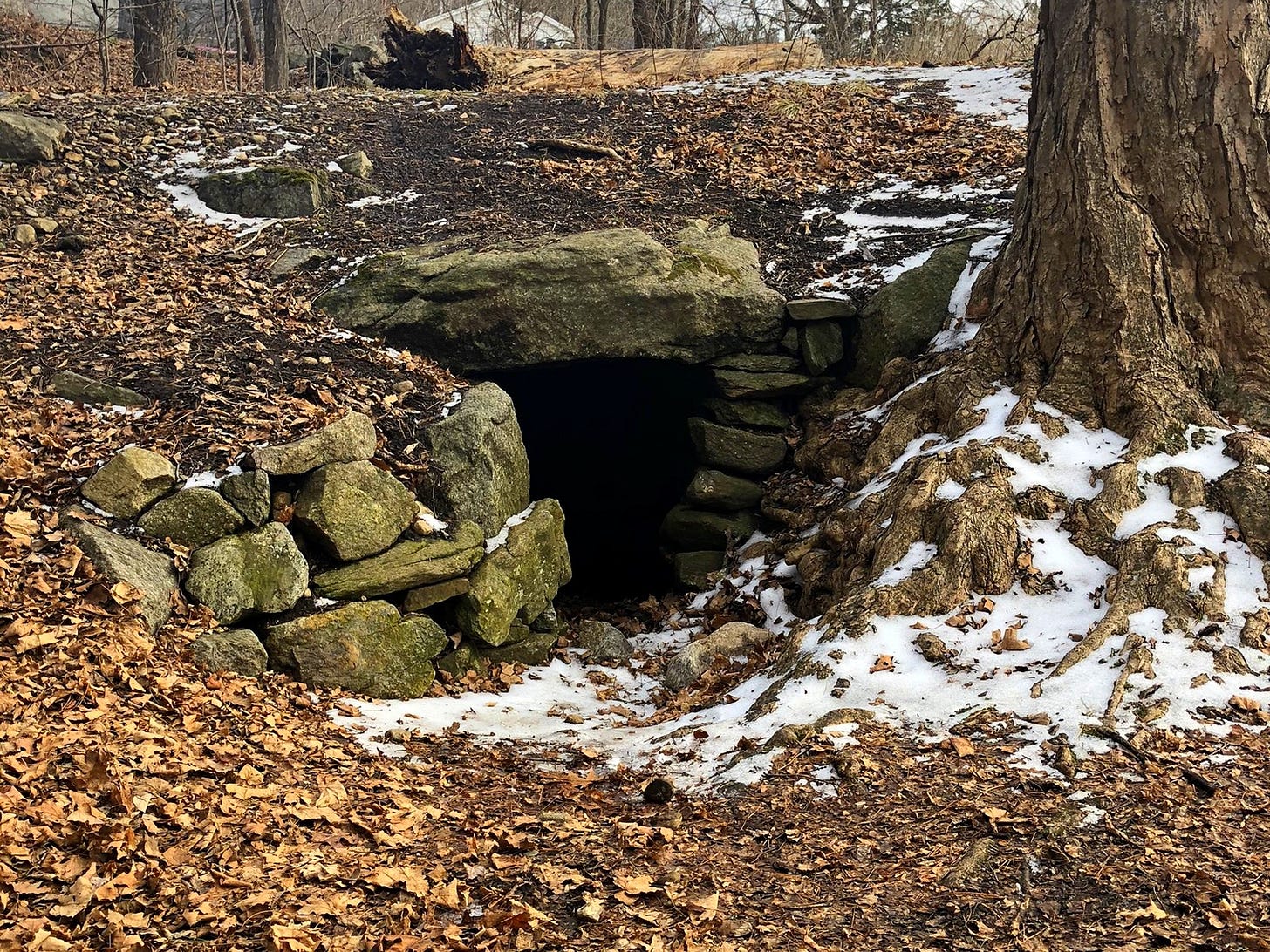
Opening myself up to any impressions the chamber might give off resulted in a profound if admittedly subjective experience which I found instructive, as it imparted both a sense of great antiquity and of fully Indigenous origins.
I’d spent years reading and researching and building hypotheses on stone sites, yet one I really hadn't considered too extensively asserted primacy for itself from that first day in the field forward. After what I experienced.
I knew a little... read some posts on Sacred Stone Landscapes, heard that some people in NEARA now thought Indigenous Peoples had worked with stone in the Northeast, and I'd stumbled across the blog Rock Piles describing possible Native American stone work. But I don’t think I’d taken it completely seriously.
There, in that space, at that time, that all changed.
Seeing and touching the stonework makes a difference. The actual experience of being inside the chamber, of allowing the stillness and calm to ground and center you, can be subtly transforming.
I tried an approach based on observations from Goethe, Edmund Husserl, Gary Lachman, and other philosophers, a sort of Active Participatory Perception, using Primary Imagination to Engage With whatever it is you are attempting to Understand.
There was a sense of something, a great, non-personal presence, of Something being there, and having been there, for a very long time. A great, still quietness. Or great, quiet stillness.
And yet? Massive.
Perhaps benevolent, but more neutral.
Watching, maybe waiting?
A sense of There, there.
Not seeking to be acknowledged, but acknowledging, if sought out.
Almost nothing, but also, almost everything.
Age. If nothing else, a sense of great age hit me in that space.
I tried my Active Participatory Perception approach and asked why this chamber was here. The Answer came with force and again that impersonal but giant feeling of Presence. It is hard to put this into words. They are inadequate.
There was again understood to be that sense of age. I felt the memory of a man coming in through the tunnel and settling down in this space, in the interior chamber. In this place, somehow, he connected back with his ancestors. I don’t know how. But I knew this was what he did.
Then, I saw this extend backward and forward through time. Man after man entering and sitting in that place and, in so doing, connecting back with all who had come before them, plugging into their memories and experiences. It was as if I saw them all at once, like the trick they do with mirrors where you see infinite reflections.
There was more which doesn’t lend itself to any prose description. But as I prepared to leave, I asked with my Active Participatory Perception approach , “what should I do?“
The answer was a resounding, “Tell people about this. Let them know.” Which came with a sense of urgency and sadness. A sense of needing to stop destruction. It all came crashing down on my head.
Or in my head, at the very least.
In a way, that’s why I’m doing what I’m doing. I had already taken extensive photos and a few videos of the places I visited that day. This, you will be surprised, is unusual for me. Or was. I never used to take a lot of pictures. I’d always been more of an audio guy than a video guy.
Something changed that day. Profound in the moment, it's now difficult to relate the full impact.
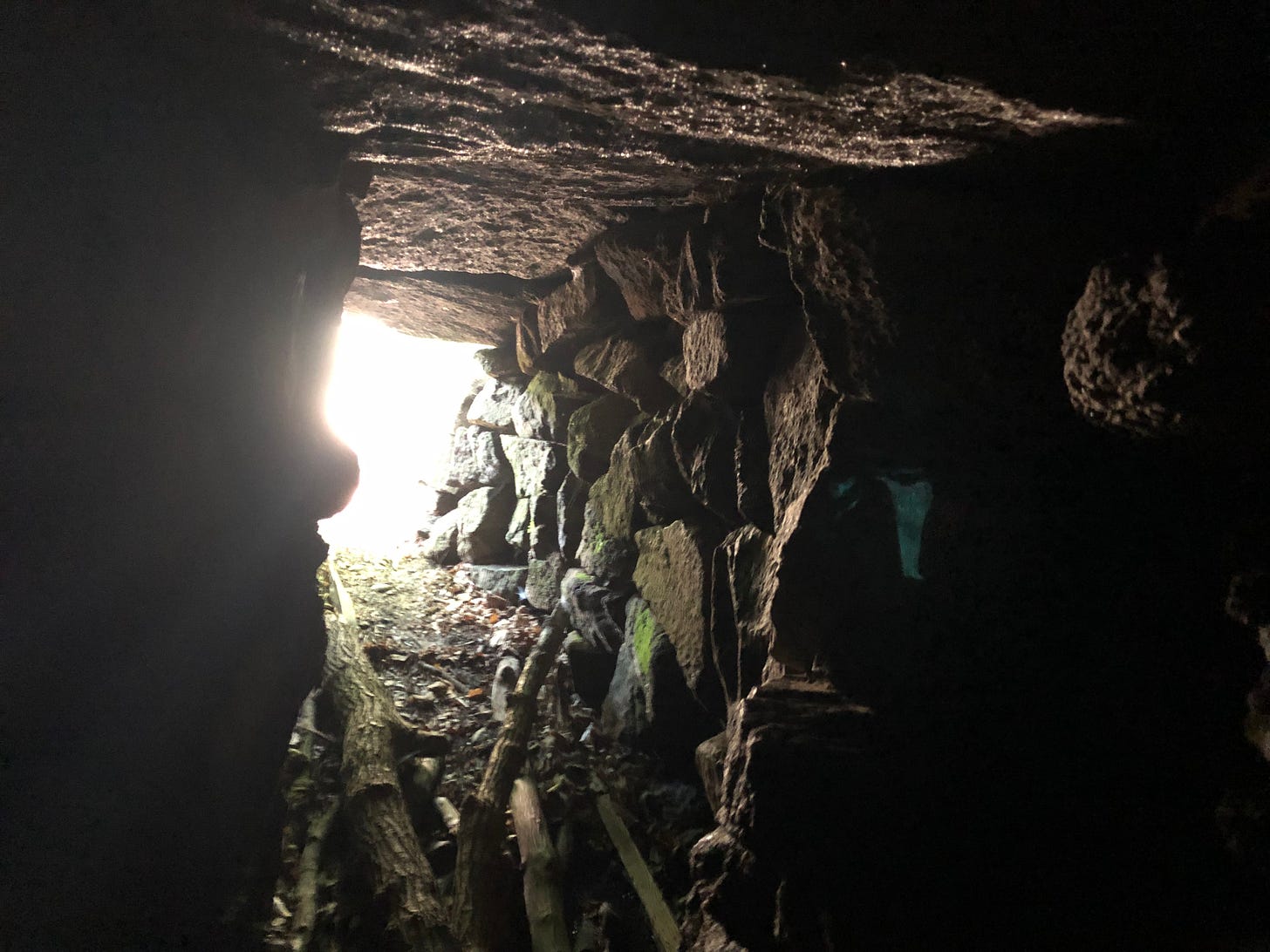
Intellectual curiosity led me to seek out the chamber. But the experience's impact was more visceral, my response intuitive. My experience that day changed the way I see the stonework, and what I see portrayed in the stonework. My ideas shifted. Thoughts of anyone but Indigenous Peoples building this chamber in ancient times, or other ancient stone works, vanished.
After this experience, it also seemed to become obvious what were ancient stone rows and what were post-Contact works. My eyes were opened. Something like putting on those shades in that movie that let you see aliens among us -- the stones just didn't look the same after this experience.
Having had such an experience, I still attempt to maintain as objective an approach to my investigations as possible. There is now an undeniable larger dimension. But Science is often guided by intuition. Journalism even more so. The key in Science is following up on “Eurekas!” and Breakthrough Moments with testable ideas in reality which are then subject to some sort of peer review.
Researchers follow-up on their “Aha!” moments by tracking down sources for corroborating or contradicting evidence or testimonies and sharing their findings, open to review. Journalists follow-up with articles, videos, blogs and social media bursts, ideas outlined in reality which are then shared and read and critiqued among peers …well, everyone, really.
I knew there was some work published in this area based on what I’d been coming across with my previous focus. I discovered a great deal of corroborative material by following up on this experience. It’s out there. It’s just not that widely known, yet.
Now, I’m contributing to the ongoing discussion in my own small way, sharing my impressions and experiences. Which I likely wouldn’t be doing if I hadn’t had this experience — I made and posted my first attempt at a video shortly after this visit.
All That From A Root Cellar?
Some insist the stone chambers of New England are nothing more than Colonial Root Cellars and/or similar farm-related structures. If that’s all you’ve heard about, this experience I’ve shared may seem pretty out there. But there is a growing consensus the Indigenous Peoples of the Northeast worked with stone, and that some stonework once deemed to have been the work of settlers and farmers is actually a great deal older.
The stonework often appears in groups, which USET, the United Southern and Eastern Tribes, term Ceremonial Stone Landscapes. Many of these sacred landscapes have been destroyed by people thinking they were just clearing piles, old stone walls… and root cellars.
Some Stone Chambers were likely used by later settlers for food or ice storage or whatever – but what were they used for before that?
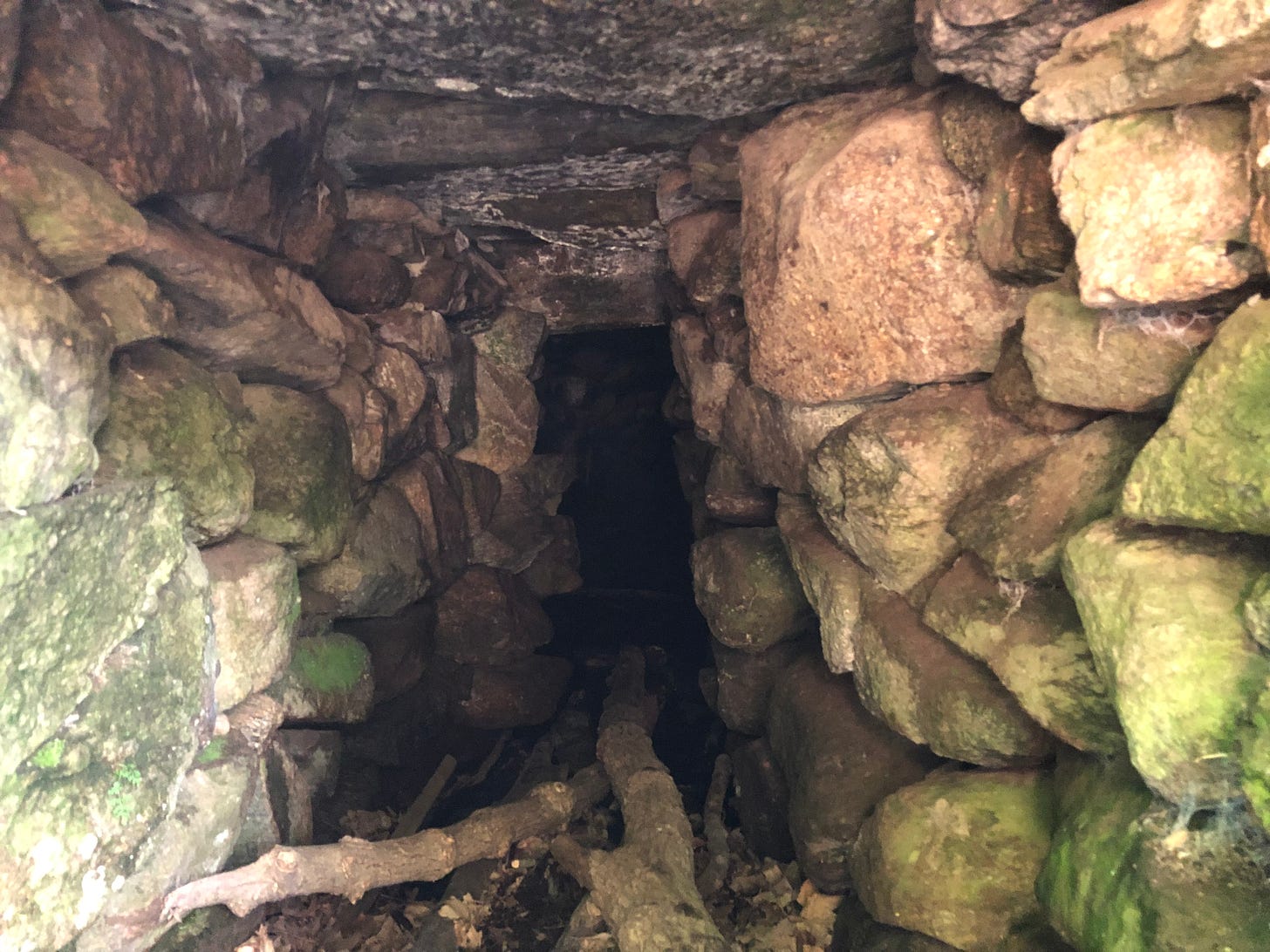
Later colonial usage doesn't invalidate earlier possible utility and construction, and in fact, later usage might wipe out or obscure any material culture – evidence – of what, if anything, went on in the chamber before it.
Admittedly, there are archaeologists in New England who disagree. Many hold a nearly dogmatic belief that all the stone workings of New England are Colonial or later. This scientism leads some archaeologists to disregard results in favor of dogmatic ideas, and has roots almost fifty years old.
In the mid to late 1970's, the mainstream archaeological community found itself pushing back against the theories of those who proposed the stone chambers and other stone works were built by pre-Columbian European explorers. This created a circle-the-wagons mentality among archaeologists around the prevailing thought at the time that all the stone work was post-Contact Colonial – which itself suffered from a racial bias against Native Americans' ability to work with stone.
While lecturing the pre Columbian theorists on their ignorance of 10,000 years of Native American habitation, the archaeologists themselves couldn't conceive of the possibility that Native Americans had anything to do with the stone works. All were deemed colonial constructs. It was, for some reason, simply a “given” that Native Americans never worked in stone.
In his 2018 book Stone Prayers, Massachusetts anthropologist and archaeologist Curtiss Hoffman faults many colleagues for indulging in dogmatic scientism for still maintaining this attitude today, a view, he said, "Developed without reference to the published literature and as far as I can tell solely based on an aversive reaction to the claims of both nonprofessional and tribal groups..."
It has no basis in fact. And was born out of backlash. It is Scientistic. Scientism. But it’s not science. It is refreshing a professional like Hoffman actively considers the potential mysteries of these stone works. Avocational archaeologists, amateurs, and researchers, have done most of the legwork up until now.
In fact, Hoffman cites two such researchers James W Mavor Jr. and Byron E Dix for their groundbreaking 1989 book Manitou, where they proposed that New England stone chambers, walls, and other workings could be of Native American origin, basing their theories on astronomical alignments they found in the stone works.
Mavor and Dix found such stellar alignments at The Upton Stone Chamber.
The Beginning
As mentioned at the outset of this admittedly subjective tale, this was only my first day in the field. It was the day after Christmas 2019; I’d used one of my gifts, the new book Archaeological Oddities by Ken Feder, to seek out these three places. I’d been lucky enough to receive a couple of guidebooks as presents, as I was planning a trip to Mound Sites in the Midwest for Summer 2020.
I’d also been researching stone chambers in New England, but remained caught up in the romantic idea Knights Templars, or Vikings, Phoenicians or maybe a Lost Tribe of Israel could have been over here exploring.
In my pursuits, I’d even asked some of my Vermont friends if they could show me to any stone chambers. At that point, no one had. The book by Feder had sites within easy driving distance of my Mom’s place, where I was staying, and so off I went.
Strange to me now, looking back, to see how I was both avidly interested in Indigenous Earthworks and Stonework in the Midwest and yet not really capable of considering how Indigenous People could have worked with stone in the Northeast. This outlook seems so foreign to me now, after that first experience and all which have come since.
This Upton Stone Chamber experience was only the beginning. Sharing that day’s pictures, videos and experiences has led to many more experiences. At the outset, I didn’t yet share the subjective part of the experience as I have above, but folks did enjoy the pictures and video of the three sites. People began to get in touch about other places. Then, folks enjoyed my impressions of those places. It sort of slowly snowballed.
Whether you dub it synchronicity or simply chalk it up to happy coincidence, it’s hard to shake the sense you’re on the right path when things keep falling into place. I share this story of depth perception with gratitude for what has been shared with me, in hopes of inspiring others, and in hope of continuing to be inspired. Thank you for reading — and for being a part of this continuing investigation and journey.





